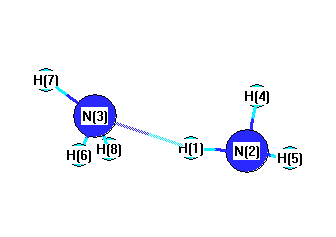Vibrational Frequencies calculated at B1B95/6-31G*
| Mode Number |
Symmetry |
Frequency
(cm-1) |
Scaled Frequency
(cm-1) |
IR Intensities
(km mol-1) |
Raman Act
(Å4/u) |
Dep P |
Dep U |
|---|
| 1 |
Ag |
3614 |
3431 |
0.00 |
|
|
|
| 2 |
Ag |
3477 |
3301 |
0.00 |
|
|
|
| 3 |
Ag |
1737 |
1649 |
0.00 |
|
|
|
| 4 |
Ag |
1171 |
1112 |
0.00 |
|
|
|
| 5 |
Ag |
482 |
457 |
0.00 |
|
|
|
| 6 |
Ag |
138 |
131 |
0.00 |
|
|
|
| 7 |
Au |
3628 |
3444 |
0.09 |
|
|
|
| 8 |
Au |
1752 |
1664 |
34.15 |
|
|
|
| 9 |
Au |
259 |
246 |
123.41 |
|
|
|
| 10 |
Au |
95 |
90 |
34.02 |
|
|
|
| 11 |
Bg |
3627 |
3443 |
0.00 |
|
|
|
| 12 |
Bg |
1740 |
1652 |
0.00 |
|
|
|
| 13 |
Bg |
126 |
120 |
0.00 |
|
|
|
| 14 |
Bu |
3616 |
3432 |
24.56 |
|
|
|
| 15 |
Bu |
3482 |
3305 |
21.30 |
|
|
|
| 16 |
Bu |
1711 |
1624 |
19.05 |
|
|
|
| 17 |
Bu |
1148 |
1090 |
370.31 |
|
|
|
| 18 |
Bu |
143 |
135 |
319.01 |
|
|
|
Unscaled Zero Point Vibrational Energy (zpe) 15972.2 cm
-1
Scaled (by 0.9493) Zero Point Vibrational Energy (zpe) 15162.4 cm
-1
See section
III.C.1 List or set vibrational scaling factors
to change the scale factors used here.
See section
III.C.2
Calculate a vibrational scaling factor for a given set of molecules
to determine the least squares best scaling factor.
Charges, Dipole, Quadrupole and Polarizability
Charges from optimized geometry at B1B95/6-31G*
Charges (e)
| Number |
Element |
Mulliken |
CHELPG |
AIM |
ESP |
| 1 |
H |
0.338 |
|
|
|
| 2 |
N |
-0.952 |
|
|
|
| 3 |
N |
-0.952 |
|
|
|
| 4 |
H |
0.307 |
|
|
|
| 5 |
H |
0.307 |
|
|
|
| 6 |
H |
0.338 |
|
|
|
| 7 |
H |
0.307 |
|
|
|
| 8 |
H |
0.307 |
|
|
|
Electric dipole moments
Electric dipole components in Debye
(What's a Debye? See section
VII.A.3)
| |
x |
y |
z |
Total |
| |
0.000 |
0.000 |
0.000 |
0.000 |
| CHELPG |
|
|
|
|
| AIM |
|
|
|
|
| ESP |
|
|
|
|
Electric Quadrupole moment
Quadrupole components in D Å
| Primitive |
|---|
| | x | y | z |
|---|
| x |
-16.193 |
4.396 |
0.000 |
| y |
4.396 |
-8.939 |
0.000 |
| z |
0.000 |
0.000 |
-12.218 |
|
| Traceless |
|---|
| | x | y | z |
|---|
| x |
-5.615 |
4.396 |
0.000 |
| y |
4.396 |
5.266 |
0.000 |
| z |
0.000 |
0.000 |
0.349 |
|
| Polar |
|---|
| 3z2-r2 | 0.697 |
|---|
| x2-y2 | -7.254 |
|---|
| xy | 4.396 |
|---|
| xz | 0.000 |
|---|
| yz | 0.000 |
|---|
|
Polarizabilities
Components of the polarizability tensor.
Units are
Å
3 (Angstrom cubed)
Change units.
| |
x |
y |
z |
| x |
1.780 |
-0.057 |
0.000 |
| y |
-0.057 |
3.359 |
0.000 |
| z |
0.000 |
0.000 |
2.723 |
<r2> (average value of r
2) Å
2
| <r2> |
64.774 |
| (<r2>)1/2 |
8.048 |
